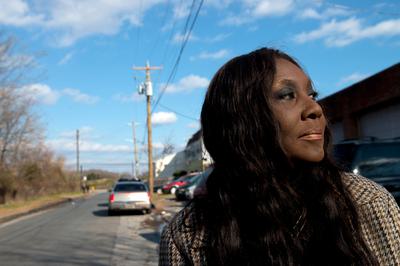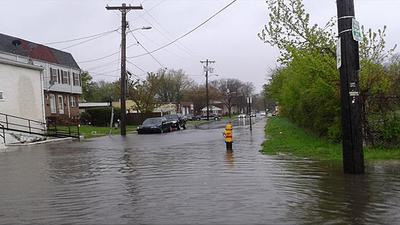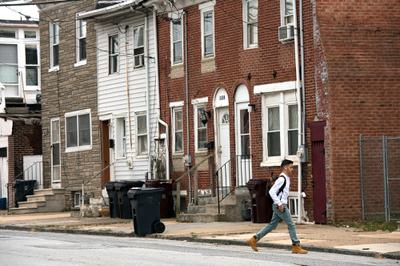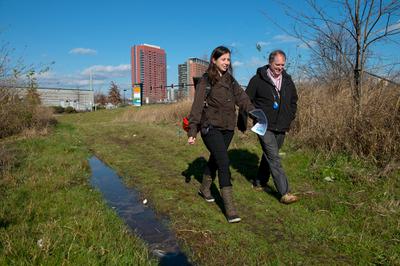Civic leader Marie Reed says residents have had to evacuate the Southbridge neighborhood three times since 2006. Peter Tobia/Yale e360
Now, says Reed, the flooding events have become more frequent and intense. “It can take only a brief rain, sometimes just 15 minutes can bring flooding,” says Reed. “It comes bubbling up from the ground.” She points out that the unrelieved flatness of the neighborhood — made up largely of short streets flanked by two-story homes — leaves no high places to retreat to. “There just isn’t anywhere to go,” she says. “We’ve had to evacuate three times since 2006.”
To make her point, Reed opens a video file on her phone that was taken last July after a “mild rain.” The video pans along on a street near the railroad tracks that run along the southern edge of Southbridge. The street is flooded, and when a car passes it creates a wave that courses toward the camera. A fire truck goes through, and the water is far up its wheel wells. “Sometimes it’s so bad here that we have to have police cars directing traffic,” says Reed. “It affects everyone trying to to get to work and get home.” The periodic flooding also means that residents are plagued by problems such as mold in their homes and mosquitoes breeding in puddles created by the receding water.
As sea level rises and changes in climate bring increases in precipitation and in the frequency and intensity of storms, the kind of flooding that has plagued Southbridge will become chronic and sometimes catastrophic, coastal experts say. Sea level globally rose by some 8 inches over the last 100 years. In the last thirty years, however, that rate has increased significantly, a trend linked to climate change as ice sheets and glaciers melt and warmer ocean waters expand. According to the U.S. National Oceanic and Atmospheric Administration (NOAA), during most of the 20th century, sea levels were rising at 0.6 inches per decade. Since 1993, however, sea level has been rising at 1.2 inches per decade.
Future sea level increases are expected to accelerate, and they will not be the same everywhere. The mid-Atlantic will be at the high end of sea level rise, NOAA says. The 2014 National Climate Assessment forecast that as sea level increases, “Populations in the current 1-in-100-year coastal flood zone … will experience more frequent flooding, and populations that have historically fallen outside the 1-in-100-year flood zone will find themselves in that zone.”
The report also concludes that sea level increases will inordinately affect the region’s “most disadvantaged populations.” That’s because, historically, communities of color were often relegated to low-lying, flood-prone lands, whose lower value also made them more affordable to lower-income groups.
A study by the Union of Concerned Scientists (UCS) found that a 5-inch increase in sea level by 2030 would triple the number of high-tide floods in roughly two-thirds of Atlantic and Gulf of Mexico coastal communities. “By 2030, several New Jersey locations can expect to average 80 to 130 tidal floods per year,” the study said. “And places such as Annapolis, Maryland, where sea level has risen 3 inches since 1990, and Washington, D.C., can expect to average 150-200 tidal floods each year.”
A cell phone photo shows flooding at A and Buttonwood Streets in Southbridge in April 2014. Leah Kacanda
Cities like Savannah, Georgia; Cambridge, Maryland; and Charleston, South Carolina, will see floods on normal high tides by 2030, according to the study. In 1970, for example, Charleston averaged six tidal floods a year. Since then, sea level has risen more than 5 inches. Charleston now experiences more than two-dozen tidal floods annually. By 2045, riding another foot or more of sea level rise, Charleston could average 180 tidal floods a year.
The non-profit group Climate Central found that “more than a quarter of the major roads in the Gulf Coast region are on lands less than 4 feet in elevation.” An EPA study estimated that by 2100 sea level rise alone will have caused some $5 trillion in coastal property damages if no adaptation measures are adopted.
In Delaware, Southbridge is hardly alone in facing a rising threat of flooding: 62,000 acres of land in the state, containing 20,000 houses and 428 miles of road, lie less than five feet above the mean high-tide mark.
All of this saltwater flooding takes its toll on storm and wastewater systems, threatens freshwater sources, damages roads and homes, and disrupts community and business life. The flooding will only be compounded by higher and more frequent storm surges and by changing weather patterns that federal scientists say will produce more extreme downpours.
Using its National Coastal Property Model, the U.S. Environmental Protection Agency (EPA) estimated that by 2100 some 1.6 million people living along the coasts will be affected by flooding due simply to sea level rise. By superimposing on that map a map of coastal areas where the residents are, the EPA found “that many socially disadvantaged Americans living in coastal areas are very likely to be disproportionately affected by SLR (sea level rise).” The EPA’s map shows entire regions where the seas will encroach upon poorer coastal communities that are “much more likely to be abandoned than protected.”
Sea level threatens small communities along both shores of Delaware Bay. On the New Jersey side, rural Cumberland County, once the center of fishing, oyster, and canning industries, is now one of that state’s poorest counties and is facing a receding shoreline with few resources for protection. Saving these bay-shore communities would be expensive, and with their dwindling populations, these areas have little political clout.
Southbridge – faced with what seemed like a slow extinction through neglect, and flooding that would only bring further economic decline – has been fighting back.
“Southbridge is only 1.6 square miles with a population of 2,000, but the community has a long history of civic activism,” said Marvin Thomas, the former president of the Southbridge Civic Association. For years the community had documented its problems and presented them to one city administration after another: Tide gates that didn’t close or that hung by a thread or were tied up with rope; drainage swales and storm grates filled with sediment.
“But documentation never brought action from the city, state, or federal government,” said Thomas. “We were told it would be too expensive.”
The causes for Southbridge’s flooding are rooted in its location and in a century-old engineering scheme. In South Wilmington the tide gates close when the tide rises. Storm and wastewater is diverted into sewers that carry it to the city treatment plant — unless rain overloads the system, in which case the overflow spills untreated out the floodgates into the Christina and downstream to the Delaware. Should the system overflow at the same time that the floodgates are shut against a high tide or a storm-related tidal surge, the storm and wastewater becomes trapped. The system backs up. The combined sewer overflow accumulates in the low-lying streets, bubbles up out of catchment basins and worst of all, comes pouring out of basement drains in Southbridge homes.
Southbridge’s older row houses, such as these along the 1000 block of A Street, are especially vulnerable, with basements flooding during heavy rains. Peter Tobia/Yale e360
In 2004, Southbridge saw its chance to solve its flooding problems. Wilmington was developing a long-term plan to comply with revised federal stormwater permit regulations. It had to improve its combined sewer overflow capture rate from 72 to 85 percent.
Meanwhile, on the far side of the wetland landfill that bordered their community, Southbridge residents saw development coming to a new, gentrifying Christina River waterfront. Southbridge didn’t want to be left out. Working with the state’s Department of Natural Resources and Environmental Control (DNREC), the community was able to get NOAA to fund a study to plan not only for flood control, but for the community’s economic growth and its part in Wilmington’s future.
A decade and many community meetings later — with federal, state, and local funding, as well as involvement from local and national environmental groups —the $24 million South Wilmington Wetlands Park project is about to begin.
Under the project, the 100-year-old plumbing will be reengineered. Thirty-six acres of combined storm and sanitary sewers will be separated. The storm sewer overflow will run into an expanded and redesigned wetland where, until it’s released into the Christina, it will supply water for a 30-some acre “wetlands park.” This award-winning urban greenspace design will feature a tidal channel that meanders among a range of designed habitats and plant communities, from marshland, to shrub meadow, to upland forest. A boardwalk that traverses the park will connect Southbridge with the gentrifying riverfront to the west.
While Bryan Lennon of the Wilmington Water Distrct says that it’s first and foremost a flood control project that will improve water quality in the Christina and Delaware rivers, the community fully expects it to improve its quality of life. As a safer and flood-resilient neighborhood adjacent to a large central park, Southbridge will, it’s hoped, attract new investments, jobs, and housing.
“This has been a community-driven effort from the time it began,” says Thomas. “We are taking care that efforts will be made to not uproot present residents. This will put a positive focus on a community that has not been looked upon positively for a number of years.”
Questions remain. Studies are ongoing with regard to the transport of contaminants from surrounding brownfield sites. If extreme rain events increase beyond even the new capacity, another pumping station may have to be added to the system. And perhaps most important is whether rising sea levels will eventually outflank the new Southbridge defenses. A 4-foot rise in sea level by the end of the century would, on an average high tide, leave much of South Wilmington flooded, even with the park project.
“It concerns me,” says Marie Reed. Everyone, she says, is aware of the predictions for sea level rise. “But this is a start.” For now, she said, residents are mainly concerned about putting an end to the flooding that has plagued Southbridge for decades.
Victor Perez, assistant professor of sociology and criminal justice at the University of Delaware, has been conducting surveys in the Southbridge community on residents’ perceptions of the risks of climate change and sea level rise. While the wetlands park plan may be an elegant adaptation to flood control, he questions whether it may ultimately be maladaptive for climate change, a stopgap plan that by century’s end might no longer function as envisioned. As Southbridge and other communities look for protection from flooding and rising seas, are they just forestalling the inevitable?
“We have to be aware that the future will look very different from today,” said Susan Love, who heads DNREC’s climate and sustainability section. And she agrees that “if we’re not designing for future conditions — in placement of structures and infrastructure — we’re doing a disservice.”
But Love, who has worked for more than a decade with Thomas and the community, insists that “retreat is not an option.” As Marie Reed points out, not only is South Wilmington a bastion of African-American history and culture, but it’s also Wilmington’s “last frontier,” with still-undeveloped land that, once the flooding is dealt with, has great economic potential.
City planner Leah Kacanda and Bryan Lennon, of Wilmington's Water Division, walk into a wetlands area that will soon be part of a new park and natural flood mitigation project. Peter Tobia/Yale e360
In this, Southbridge may differ from many poorer coastal communities pressured by sea level rise. Delaware, as Love points out, is also a state with only 57 municipalities and 950,000 people. Ninety percent of the state’s coastal zone is protected and undeveloped. “Our management decisions are to allow natural coastal processes to occur, and as sea level rises, allow wetlands to migrate inland,” she says. So she feels an obligation to protect those remaining small and vulnerable coastal populations.
While scientists can make projections for long-term sea level rise, governments have difficulty making long-term plans. “We’re not set up to do that in the United States,” said Young of Western Carolina University. “The political cycle is two to four years, eight years max.”
He can understand the kind of effort undertaken in Southbridge.
“Charleston has an absolutely booming economy,” says Young. “If you have to invest $20 to $30 million to help storm water problems that will enable the city to function well the next 10 years, it’s probably worth the money. But if you think that’s all you have to do … ”
He says it often comes down to making a cost/benefit analysis, adding, “In Miami you can justify anything … The problem is that we don’t have a national vision for when and where we should be spending federal dollars along the coast.”
Wilmington has engaged the consulting firm of ARCADIS, North America to look into dealing with future sea level rise. Based in the Netherlands, its U.S.-based national director for Flood Risk and Resiliency is Edgar Westerhof. From his work with the City of Boston and other communities in the U.S., Westerhof says he’s learned that engineers can benefit from listening to the community. The lesson he hopes U.S. cities will learn from his Netherlands home is that “flood control is not just an end in itself, but must become a part of the economic life of the community.”
Securing Southbridge’s future may, however, depend upon bigger flood control projects. “The [U.S.] Army Corps of Engineers once had a plan to build a seawall around South Wilmington,” says Love. “We’re now only beginning to think about it again.”






